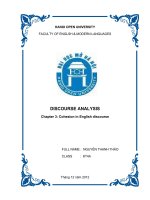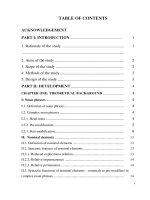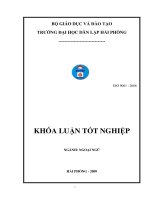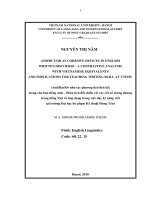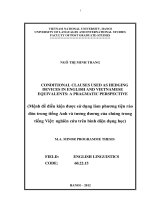Determiners as discourse referents in English
Bạn đang xem bản rút gọn của tài liệu. Xem và tải ngay bản đầy đủ của tài liệu tại đây (611.45 KB, 69 trang )
BỘ GIÁO DỤC VÀ ĐÀO TẠO
TRƯỜNG ĐẠI HỌC DÂN LẬP HẢI PHÒNG
-------------------------------
ISO 9001 : 2008
KHÓA LUẬN TỐT NGHIỆP
NGÀNH: NGOẠI NGỮ
HẢI PHÒNG - 2009
1
HAIPHONG PRIVATE UNIVESITY
FOREIGN LANGUAGES DEPARTMENT
-----------------------------------
GRADUATION PAFER
DETERMINERS AS DISCOURSE REFERENTS
By:
Hoàng Thị Thu Hằng
Class:
NA902
Supervisor:
Trần Thị Ngọc Liên
HAI PHONG - 2009
2
BỘ GIÁO DỤC VÀ ĐÀO TẠO
TRƯỜNG ĐẠI HỌC DÂN LẬP HẢI PHÒNG
--------------------------------------
Nhiệm vụ đề tài tốt nghiệp
Sinh viên: ............................................................Mã
số:............................
Lớp: .............................Ngành:.............................................................
.......
3
Tên đề
tài:
.................................................................................................
..........................................................................................
........
..........................................................................................
.......
..........................................................................................
........
Nhiệm vụ đề tài
1. Nội dung và các yêu cầu cần giải quyết trong nhiệm vụ đề tài tốt
nghiệp
( về lý luận, thực tiễn, các số liệu cần tính toán và các bản vẽ).
……………………………………………………………………………..
……………………………………………………………………………..
……………………………………………………………………………..
……………………………………………………………………………..
……………………………………………………………………………..
……………………………………………………………………………..
……………………………………………………………………………..
……………………………………………………………………………..
2. Các số liệu cần thiết để thiết kế, tính toán.
……………………………………………………………………………..
……………………………………………………………………………..
……………………………………………………………………………..
4
……………………………………………………………………………..
……………………………………………………………………………..
……………………………………………………………………………..
……………………………………………………………………………..
……………………………………………………………………………..
……………………………………………………………………………..
3. Địa điểm thực tập tốt nghiệp.
……………………………………………………………………………..
……………………………………………………………………………..
……………………………………………………………………………..
CÁN BỘ HƯỚNG DẪN ĐỀ TÀI
Người hướng dẫn thứ nhất:
Họ và tên:.............................................................................................
Học hàm, học vị:...................................................................................
Cơ quan công tác:.................................................................................
Nội dung hướng dẫn:............................................................................
Người hướng dẫn thứ hai:
Họ và tên:.............................................................................................
5
Học hàm, học vị:...................................................................................
Cơ quan công tác:.................................................................................
Nội dung hướng dẫn:............................................................................
Đề tài tốt nghiệp được giao ngày..........tháng .......năm 200
Yêu cầu phải hoàn thành xong trước ngày.......tháng.........năm 200
Đã nhận nhiệm vụ ĐTTN
Đã giao
nhiệm vụ ĐTTN
Người hướng dẫn
Sinh viên
Hải Phòng, ngày ...... tháng........năm 200
HIỆU TRƯỞNG
GS.TS.NGƯT Trần Hữu Nghị
6
PHẦN NHẬN XÉT TÓM TẮT CỦA CÁN BỘ HƯỚNG DẪN
1. Tinh thần thái độ của sinh viên trong quá trình làm đề tài tốt
nghiệp:
……………………………………………………………………………..
……………………………………………………………………………..
……………………………………………………………………………..
……………………………………………………………………………..
……………………………………………………………………………..
……………………………………………………………………………..
……………………………………………………………………………..
……………………………………………………………………………..
2. Đánh giá chất lượng của khóa luận (so với nội dung yêu cầu đã đề
ra trong nhiệm vụ Đ.T. T.N trên các mặt lý luận, thực tiễn, tính toán
số liệu…):
……………………………………………………………………………..
……………………………………………………………………………..
……………………………………………………………………………..
……………………………………………………………………………..
……………………………………………………………………………..
……………………………………………………………………………..
……………………………………………………………………………..
……………………………………………………………………………..
……………………………………………………………………………..
3. Cho điểm của cán bộ hướng dẫn (ghi bằng cả số và chữ):
……………………………………………………………………………..
……………………………………………………………………………..
……………………………………………………………………………..
7
Hải Phòng, ngày ….. tháng ..… năm
2009
Cán bộ hướng dẫn
(họ tên và chữ
ký)
NHẬN XÉT ĐÁNH GIÁ
CỦA NGƯỜI CHẤM PHẢN BIỆN ĐỀ TÀI TỐT NGHIỆP
1. Đánh giá chất lượng đề tài tốt nghiệp về các mặt thu thập và phân tích
tài liệu, số liệu ban đầu, giá trị lí luận và thực tiễn của đề tài.
8
2. Cho điểm của người chấm phản biện :
(Điểm ghi bằng số và chữ)
Ngày.......... tháng......... năm 2009
Người chấm phản biện
9
TABLE CONTENT
INTRODUCTION
1. Rationale of the study..............................................................2
2. Aims of the study.....................................................................3
3. Scope
of the study.....................................................................4
4. Methods of the study................................................................4
5. Design of the study...................................................................5
DEVELOPMENT
CHAPTER 1: THEORETICAL BACKGROUND
I. Determiner.....................................................................................6
1. Definition of determiner.........................................................................6
2. Classes of determiners............................................................................6
II. Discourse reference..............................................................................12
1. Reference..............................................................................................13
2. Types of discourse reference................................................................14
3. Reference word.....................................................................................18
4. Reference items in English...................................................................18
III. Cohesion.............................................................................................21
1. Cohesion and types of cohesion...........................................................21
2. Cohesive devices to create coherence in texts......................................22
CHAPTER 2: DETERMINERS AS DISCOURSE REFERENTS
1. Determiners as anaphoric reference.....................................................25
1.1. Definite articles as anaphoric reference...........................................25
10
1.2. Demonstratives as anaphoric reference...........................................30
1.3. Possessive determiners as anaphoric reference...............................32
2. Determiners as cataphoric reference....................................................33
2.1. The Definite article as cataphoric reference....................................33
2.2. The demonstrative determiners as cataphoric.................................35
2.3. Possessive as cataphoric reference..................................................36
3. Determiners as exophoric reference ....................................................37
3.1. The definite article as exophoric reference......................................37
3.2. Demonstratives determiners as exophoric reference...........................................39
CHAPTER 3: APPLICATION OF DETERMINERS AS DISCOURSE
REFERENTS TO CREATE COHESION IN A TEXT
1. Cohesion...............................................................................................40
2. Application of determiners as discourse referents to create cohesion in a
text.........................................................................................................40
3. Some possible difficulties in interpreting the text and suggestions to
overcome..................................................................................................46
3.1. Some possible difficulties in interpreting in the text.........................46
3.2. Suggestions to overcome the problems.............................................49
PART 3: CONCLUSION..........................................................................52
REFERENCES
APPENDIX
11
12
ACKNOWLEDGEMENTS
To complete this research paper, I have a great deal of help, guidance
and encouragement from my lecturers and my friends.
First of all , I would like to express my deepest thank to my supervisor,
Mrs. Tran Thi Ngoc Lien (M.A) who has always been most willing and
ready give me suggestions to complete this study . I also would like to
express my sincere thanks to all lecturers in the department of foreign
language for their precious lectures during 4 years and contribution which
help me to have ideas and knowledge to found this study.
This research paper has been completed my best knowledge. However,
mistakes and shortcomings are unavoidable because of my limited
knowledge. Therefore, I‘m looking forward to receiving the reflection,
sympathy and contribution from lecturers to make it more perfect.
Hai Phong, June 2009
Hoang Thi Thu Hang
13
PART ONE:
INTRODUCTION
I. Rationale of the study
Language is a typical and essential product of each nation because it is
the individual features of each country. Also, language is a mean to
communicate and exchange information, culture, technology, science
among countries. Although English is not the most widely spoken language
in the world in terms of the number of native speakers, it is considered as a
global language. In the era of global integration, this language becomes
increasingly important as it enables people to communicate on a global
basis.
Using English effective and making a good living have much in
common .The study of English encompasses much more than the
mechanics of grammar, punctuation and spelling. The ability to handle
language effectively and clearly is valuable in any occupation which many
people may pursue. Professional schools find that learners who have
specialized narrowly in their undergraduate education often enter without
broad general knowledge and without skill of communication necessary for
success in their chosen professions.
Thus, English is becoming compulsory subject at school. English
curriculum develops learners‘ ability to communicate and also fosters a
strong liberal arts background, marketable communication skill….
Discourse analysis can be applied to any text, that is, to any problem or
situation. It has no definite guidelines to follow because it is basically an
interpretative and deconstructing reading. Being aware of any text‘s
multiple meanings, discourse analysis does not provide definite answers,
14
but rather expands our personal horizons (Palmquist, 2004). Researchers,
however, have recognized some subsections and research areas in
analyzing the discourse which is described in the simplest terms as verbal
expression in speech or writing. In the first place, drawing a distinction
between analyses of spoken discourse, which is sometimes called
―conversational analysis‖ and analysis of written discourse, which is
sometimes called ―text linguistics‖
Richards et al (1992:111) summarizes what discourse analysis deals
with:
A. how the choice of articles, pronouns, and tenses affects the structure of
the discourse i.e. how cohesion is created
B. the relationship between utterances in a discourse
C. the moves made by the speakers to introduce a new topic, change the
topic, or assert a higher role relationship to the participants.
In this paper, I focus on the determiners as discourse reference with the
aim of helping English learners to make a better choice of using
determiners which may affect the structure of the discourse
II .Aims of the study
The study is aimed at:
- providing an overall investigation into determiners as
discourse referents
- elaborating the types, function of determiners in discourse
reference
- showing the application of determiners as discourse referents
in cohesion of a text
15
III. Scope of the study
English has a number of signals to mark the identity between what is
being said or talked about and what is said before, this relationship is often
called in semantic reference. Realizing these signals is usually not a
problem for the people who have grown up speaking English, for others
though, this can be a considerable obstacle on the way to their mastery of
English. In fact, it‘s hard to cover all discourse reference. Therefore, in this
paper I want to focus on determiners as discourse referents.
Efforts were made to do this paper as I hope this study to some extent
will help those who care about discourse reference, especially, determiners
as discourse referents
IV .Methods of the study
To conduct the study, there should be different methods combined such
as quantitative method with data analysis and interpretive method.
First, data were collected from reliable sources such as academic books,
websites. Then they are analyzed in order to help the researcher find out
how frequently determiners occur in English sentence and how they can act
as discourse referents.
Secondly, from the data, the researcher hypothesizes the function and
effects of determiners as discourse referents. And from comparative and
contrastive analysis, the researchers can work out the role of determiners as
discourse referents in English text.
V. Design of the study
This paper is divided into three parts. The first is Introduction
providing rationale, aims of the study, scope of the study, methods of the
16
study, design of the study. The second is Development consisting of three
chapters. Chapter 1 supplies the basic concepts, subclasses of Determiner,
discourse reference, and items of discourse reference. Chapter 2 gives
English Determiner as discourse reference and its subclasses. In chapter 3,
that is about application of determiners as discourse referents in cohesion
text and. The last part is Conclusion with some implication for studying
English
17
PART TWO: DEVELOPMENT
CHAPTER 1: THEORETICAL BACKGROUND
I. DETERMINERS
1. Definition of determiner
A determiner is a noun modifier that expresses the reference of a noun
or noun phrase. Determiners make it clear, for example, which particular
thing(s) we are referring to or how much of a substance we are talking
about.
(L. G. Alexander, 1988: 55)
2. Classes of determiners
2.1. Definite and indefinite articles
An article combines with a noun to indicate the type of reference being
made by the noun, and may also specify the volume or numerical scope of
that reference. The articles in the English language are ―the” and ―a” (the
latter with variant form an). Articles are traditionally considered to form a
separate part of speech. Linguists place them in the category of
determiners.
2.1.1. Definite article (The)
In English, a definite article is mostly used to refer to an object or
person that has been previously introduced.
18
Example:
An elephant and a mouse fell in love.
The mouse loved the elephant's long trunk
and the elephant loved the mouse's tiny nose.
(L. G. Alexander, 1988: 67)
―A mouse‖ in the first line became ―the mouse‖ because ―a mouse‖ had
been previously introduced into the narrative. And no other mouse was
involved in the paragraph. Only previously introduced subjects, and unique
subjects, where the speaker can assume that the audience is aware of the
identity of the reference typically take definite articles in English.
The word ―the‖ the only definite article in English. It is also the most
frequently used word in English. The article “the” is used with singular and
plural, countable and uncountable nouns when both the speaker and listener
know the thing or idea already. The article ―the‖ is often used as the very
first part of a noun phrase in English.
Example:
The end of time is begins now
Here, "the end of time" is a noun phrase. ―The‖ signals that the
reference is a specific and unique instance of the concept (such as person,
object, or idea) expressed in the noun phrase. Here, the implication is that
there is one end of time, and that it has arrived.
Example:
The time is 3 p.m.
There are many times, but the meaning here is the time ―now‖ of which
(at the moment the sentence was produced) there is only
19
―The‖ is used in sentences or clauses where we define or identify a
particular person or object:
Examples:
―Which car did you scratch?‖
―The red one‖
'The' is used to refer to objects we regard as unique:
Example: the sun, the moon, the world
'The' is used with adjectives, to refer to a whole group of people:
Example: the Japanese, the old
2.1.2. Indefinite article (a, an)
The indefinite article is just the opposite of the definite article. In
English, the indefinite articles are “a, an” They are ―indefinite‖ because
they do not refer to a particular thing as ― the ‖ does, but simply refer to an
object or person in a non-specific way, that is, we do not specify exactly to
which person or object we are referring to.
Example:
There is a white house on a green hill.
A cat ate the sardine
We are not specifying which cat ate the sardine it could have been any
cat.
2.2. Demonstratives (this, that, these, those)
The demonstratives show where an object or person is in relation to the
speaker. This (singular) and these (plural) refer to an object or person near
the speaker. That (singular) and those (plural) refer to an object or person
further away. . It can be a physical closeness or distance as in:
20
Who owns that house? (distant)
Is this John's house? (near)
Or it can be a psychological distance as in:
That‘s nothing to do with me. (distant)
This is a nice surprise! (near)
It is relatively common for a language to distinguish between
demonstrative determiners (or demonstrative adjectives, determinative
demonstratives)
and
demonstrative
pronouns
(or
independent
demonstratives).
A demonstrative determiner modifies a noun:
This apple is good.
I like those houses.
A demonstrative pronoun stands on its own, replacing rather than
modifying a noun:
This is good.
I like those.
There are five demonstrative pronouns in English; this, that, these,
those and the less common yonder (the latter is usually employed as a
demonstrative determiner; even so it is rarely used in common English).
As is obvious from the examples, English employs the same words for both
types of demonstratives. Sometimes a difference is made specific by using
the pronoun one (this one, those ones).
21
2.3. Possessive adjectives (My, our, his, her, its, your and
their)
Possessive adjectives show possession, i.e. that someone or something
belong to somebody. They answer the question whose? The possessive
adjectives ―my, your, etc‖ they are determiners and must always be used in
front of a noun. Their form is regulated by the possessor, not by the thing
possessed. For example: ―his‖ refers to possession by male: John‘s
daughter (= his daughter). ―Her‖ refers to possession by female: Jane‘s son
(= her son)
Example:
Jane's brother is married to John's sister.
Her brother is married to his sister.
In English, possessive adjectives refer to the possessor, not the object
or person that is possessed
Possessive adjectives are only considered determiners when they
precede a noun head (remember that it is exactly the fact that they occupy
this position that identifies the class of „determiners‟, so this is not
surprising). „My‟, „your‟ and „our‟ are deictic. Third person genitive
determiners instead have anaphoric reference.
2.4. Quantifiers
Quantifier are words or phrases like
few , little , plenty (of )…, which
often modify nouns and show how many thing or how much of something
we are talking about . Some quantifiers combine with countable noun;
some with uncountable noun and some with both kinds
There are two small groups of closed - system quantifiers:
22
(1) Many, (a) few, and several co-occur only with plural count nouns:
Example:
The few words he spoke were well chosen
(2) Much and (a) little co-occurs only with non-count nouns:
Example:
There hasn‘t been much good weather recently
In case of few and little there is a positive /negative contrast according
as the indefinite article is or is not used
Example:
He took a few biscuits (= several)
He took few biscuits (= not many)
Exact indication of quantity can be conveyed by means of numbers.
Cardinal numbers can be used as quantifiers (two apples). The number one
can combine with any noun used as single countable noun
Example:
We‘ve got one micro and two electric typewriters in our
office
All other numbers combine with plural countable nouns
Example:
I want to buy two cabbages and twelve oranges
2.5. Interrogative determiners (Which, what, whose)
They stand for one of the other determiners in a question
Example:
A: Which book did you choose?
B: I choose this book.
23
‗Which‘ and ‗what‘ have slightly different uses: which is used when
the options are clear, what when the options are not constrained. ―Whose‖
is both interrogative and genitive.
II. DISCOURSE REFERENCE
Discourse analysis is a general term for a number of approaches to
analyzing written, spoken or signed language use. Discourse analysis is
concerned with the study of the relationship between language and the
contexts in which it is used. It grew out of work in different disciplines in
the 1960s and early 1970s, including linguistics, semiotics, psychology,
anthropology and sociology. The linguistic philosophers such as Austin
(1962) , Searle (1969) and Grice (1975) were influential in the study of
language in social action, reflected in Speech Act Theory and the
formulation of Conversational Maxims, alongside the emergence of
pragmatics , which is the study of meaning in context (e.g. Levinson 1983
and Leech 1983 ). British discourse analysis was greatly influenced by
M.A.K. Halliday's functional approach to language.
Discourse is language in use for communication and it is generally
pre-supposed to be coherent (understandable). Discourse analysis is the
search to discover what makes language coherent. Language rules morphological, syntactic and semantic plus "knowledge of the world" are
required to understand discourse. Language as a formal system plus
schemata-social, cultural, experiential and creative experiences are needed.
I.e. social and psychological context is important for the understanding of
language.
24
The
objects
of
discourse
analysis—discourse,
writing,
talk,
conversation, communicative event, etc.—are variously defined in terms of
coherent sequences of sentences, propositions, speech acts or turns- at- talk.
1. Reference
In presenting the traditional semantic view of reference Lyons (1986:
4040) says that ―the relationship which holds between things is relationship
of reference: words refer to things this traditional view continues to be
expressed in those linguistic studies (e.g.: lexical semantic) which describe
the relationship between a language and the words, in the absence of
language users. Yet, Lyons, in a more recent statement on the nature of
reference makes the following point ―it is the speaker who refers (by using
some appropriate expression) he invests the expression with reference by
the act of referring‖ (1977: 177). It is exactly this latter view of the nature
of reference which the discourse analyst has to appeal to. There is support
for such a pragmatic concept of reference in Strawson‘s (1950) claim
that ―referring‖ is not something an expression does; It is something that
someone can use an expression to do‖, and in Searl‘s view that ―in the
sense in which speakers refer expression do not refer any more than they
make promises or give orders (1979 : 155 ). Thus, in discourse analysis,
reference is treated as an action on the part of the speaker (writer). In the
following conversation fragment, we shall say, for example, that speaker
uses the expression ―my uncle‖ and ―he‖ to refer to one individual and ―my
mother‘s sister‖ and ―she‖ to refer to another.
25
